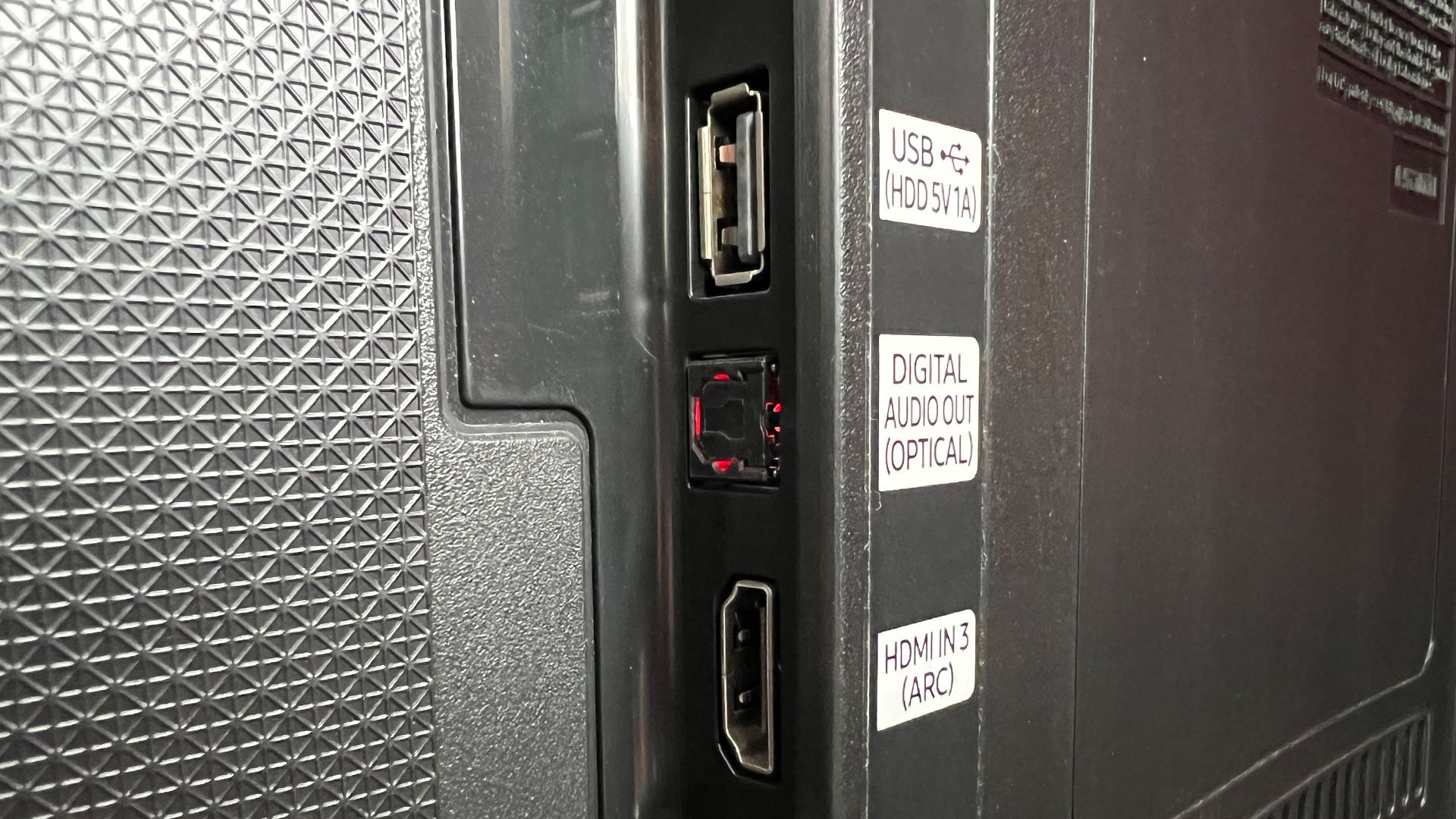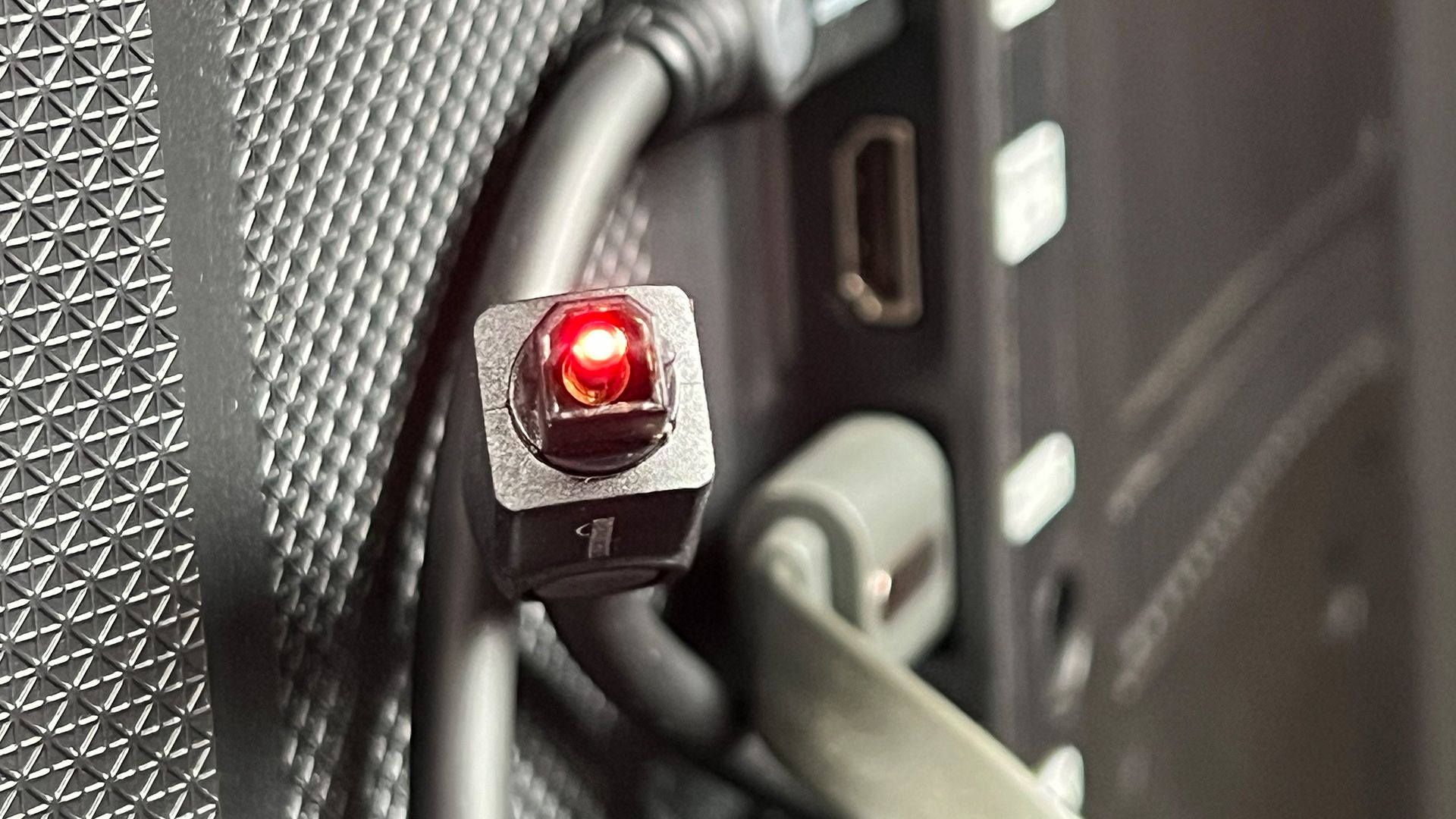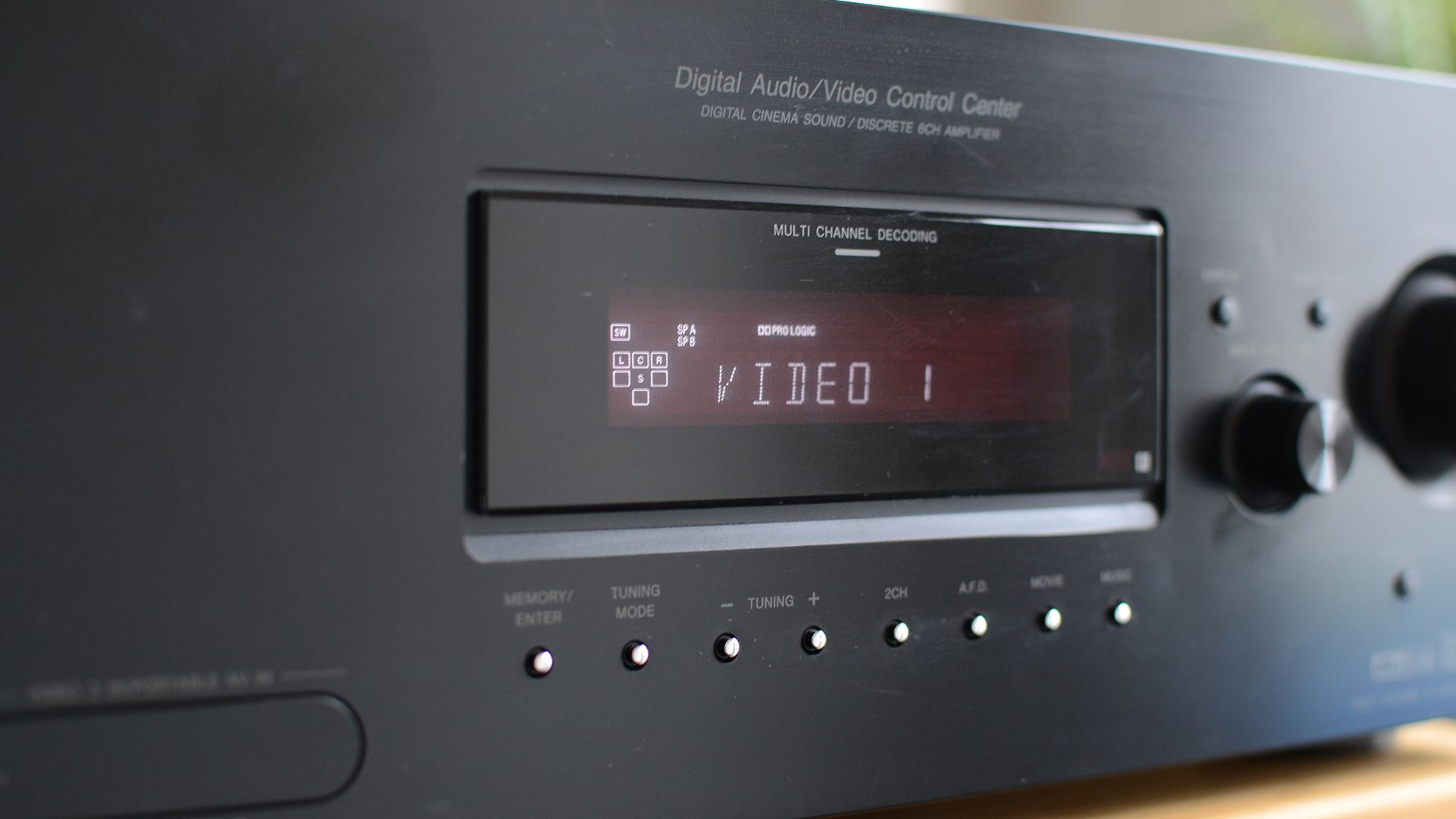Quick Links
Key Takeaways
- The optical audio port, also known as TOSLINK, can be useful for connecting older sound systems or linking devices like soundbars to TVs.
- TOSLINK cables use fiber optic technology to transmit digital audio signals, which makes them distinct from other types of audio cables that use electrical signals.
- TOSLINK cables can still be valuable in situations such as connecting older audio gear, isolating audio signals from noise, such as ground loop humming.
Ever wonder what that trapezoidal "optical" audio port is? You'll find these on the back of computers, HDTVs, media receivers, and more, but hardly anyone uses them. That little oft-neglected port can be a real life saver, though. Let's look at what it is and how you can take advantage of it.
What Exactly Is Optical Audio?
The vast majority of cabling you use for your media centers, personal computers, and audio/visual equipment uses electrical signals. Be it analog or digital, the signal is sent as an electrical impulse over conductive wire. Every cable, from the speaker wire on your 1970s turntable to the HDMI cable on your new HDTV, contains wires, wires, and more wires inside.
The one standout in home audio/video market is the optical audio cable. Unlike other cabling standards, the optical audio system uses fiber optic cables and laser light to transmit digital audio signals between devices.
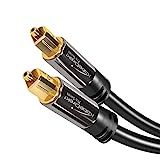
TOSLINK Optical Audio Cable
This basic TOSLINK digital optical audio cable is perfect for linking your TV to your old sound bar, stereo receiver, and more.
The standard was introduced way back in 1983 by Toshiba, and was originally intended for use with their fledgling Compact Disc players. (This is why you'll sometimes hear them referred to as Toshiba-Link, or TOSLINK cables.)
You can check if your devices support TOSLINK audio cabling by looking on the back of the device for the distinct TOSLINK port. The port is typically labeled "optical audio", "TOSLINK", "Digital Audio Out (Optical)" or something similar, but you certainly don't need a label to identify it.
The TOSLINK port is distinct among all other ports and looks strikingly like a tiny little doggie door into the bowels of your device. Even more distinctive than shape is the fact that when the device is powered on, you can see a faint glow of red light around the port door (see the photo at the top of this article) and at the end of a TOSLINK cable when you plug it in (as seen below).
Although the standard is over thirty years old now, it has been refined quite a bit, and modern TOSLINK connections are as useful as ever. So why is the lonely optical cable so underutilized?
While that question could be a historical inquiry unto itself, here's the short version: when TOSLINK came out, it was overpowered for most people's needs, and by the time the average consumer was rocking an intense home theater, the TOSLINK cable had been eclipsed by the HDMI cable.
HDMI is not only simpler, since it carries video and audio together, but it also supports newer high resolution audio formats like Dolby TrueHD and DTS HD Master Audio. TOSLINK does not.
The Many Uses of Optical Audio (Even Today)
If HDMI has mostly replaced TOSLINK, then why should you even care? While it's absolutely true that the TOSLINK cable has been largely rendered obsolete, for video systems at least, by HDMI, that doesn't mean the TOSLINK cable should be relegated to Museum of Obsolete Ports and Standards to live out its life in a display case next to SCSI cables and parallel port expansion cards.
The TOSLINK system is still capable of carrying up to 7.1 channels of very high-resolution audio. For the majority of consumer setups, there will be absolutely no discernible difference between audio quality when using an HDMI cable or a TOSLINK cable.
Our goal isn't to convince you to switch from HDMI cables to TOSLINK. If all your devices are functioning just the way you want in an all HDMI environment, then by all means carry on. Our goal is to highlight how the TOSLINK standard is the unsung hero, the hail-Mary-pass if you will, of the digital audio world. Just when you think you're out of luck, just when you think there is no way to accomplish the audio-system-wrangling required to achieve your goal, the TOSLINK cable can often save the day.
Let's look at three common situations where it is beneficial to use TOSLINK over HDMI.
Keeping Older Audio Gear In Service
Linking old audio gear to newer systems is probably the most common and pressing reason people turn to the TOSLINK standard today. If you have a wonderful and high-quality older stereo receiver that has every port under the sun except HDMI inputs, TOSLINK is solution you need.
You don't have to take your premium paid-$1000-for-it-back-in-the-day receiver and put it on Craigslist for pennies on the dollar. The vast majority of HDTV sets as well as many Blu-ray players, game consoles, and other devices, still have TOSLINK out ports.
You can pipe the HDMI video from the source (say your cable box) into your TV, then turn right back around and pipe the optical audio out to your receiver and speaker system.
Remember, TOSLINK has been on the market since 1983: there is good chance that a premium audio/video receiver manufactured anytime in the few decades has a TOSLINK port.
Connecting a Soundbar to Your TV
Although connecting a soundbar to your TV is often a subset of our previous point, regarding keeping older gear in service, there are actually two different reasons why you might want to use the optical digital audio connection on your TV with your soundbar.
First, you may have an older soundbar, TV, or both that don't support HDMI ARC (Audio Return Channel). HDMI ARC allows your TV to send audio to an attached sound system that also supports the specification. If either your sound bar or TV lacks HDMI ARC support, you're out of luck and should fall back on optical digital audio.
Second, you might have devices that support HDMI ARC (on paper at least) but you run into issues where certain types of audio or audio from certain sources won't work properly. In that case, you should consider giving up on HDMI ARC, which can be hit or miss for many people, and again fall back on the TOSLINK connection to link your TV and soundbar.
Isolating The Audio
You can separate the audio signal from an HDMI cable, but it's a finicky business that requires decoders, adapters, and a bunch of nonsense bordering on digital black magic depending on what devices you're trying to link together.
While you can use a $30-40 HDMI audio extractor like highlight in this guide to using your PC to game in another room, you might not be super happy with it. HDMI is fussy and you may find yourself buying more than one adapter to get it to work the way you expect (and replacing that adapter in the future if you get a new TV or other hardware and HDMI encryption standards change).
There's a reason one of our most popular HDMI articles is about dealing with the headache of HDMI HDCP. When HDMI works perfectly it works perfectlyand when it doesn't you're left troubleshooting. If you have any reason at all to isolate the audio signal from a digital source it is almost always, without a doubt, easiest to do so via TOSLINK cables.
Let's say, for example, you want to use your Blu-ray player as CD player, but don't want to have to turn your TV on to listen to those CDs. If the Blu-ray player has a TOSLINK port, you can pipe out the audio through the optical port to your speakers or receiver.
Here's another example: you have a nice set of speakers hooked up to a quality receiver, but that receiver is old enough that it has no digital connections to speak of — including no TOSLINK port. Put a $15 optical-to-analog converter between your optical audio out and your receiver, and you're in business.
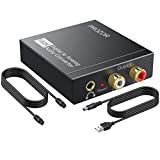
Prozor Digital to Analog Audio Converter
This simple converter takes the optical output from your TV or other source and converts to analog output via 3.5mm headphone jack or RCA stereo connectors.
You can break the audio out of its digital cage and pipe it into any analog device you want: your wireless headphones, your old receiver, your 1990s-era whole-house audio system, or any other system that only accepts analog audio.
What if you want to use a pair of analog headphones with your TV, but your spouse wants to use the speakers so they can listen at a different volume? Many television sets and receivers have a plain old headphone jack, but most of them kill the audio to the speakers when a headphone cable is plugged in. In this situation, you can use that same TOSLINK converter to send that audio to whatever you want, without the hassle of HDMI content protection standards.
Eliminating Ground Loop Hum
From an electrical engineering standpoint, ground loops are a fairly complex subject. Rather than dive into an arcane description of what a ground loop is (feel free to do some advanced reading on the topic if you're curious), it's sufficient to say that a ground loop can occur in your home when there is more than one path for electricity to take to the ground. A side effect of this in audio-video systems is speaker hum.
One of the most common causes of a ground loop in home media gear is poorly grounded cable TV equipment. In this situation, your power outlets and the connected media equipment are on one ground (hopefully, if your house is up to code, the main earth-ground spike outside), but the coax cable is grounded to another ground. Often the other ground is a water-pipe ground if there is a water pipe or spigot near where the cable connection enters the home. At some point in the past an installer likely grounded off the nearby pipe.
This disparity between the placement, capacity, and total potential energy of the two different grounding locations causes, in a manner of speaking, congestion in the electrical system. At best, this ground conflict does nothing, and you never even notice. Sometimes, though, it can cause humming over your speakers and even potentially damage your equipment. In a perfect world, we would all hunt down the source of the ground loop and fix it, but sometimes you're at the mercy of your environment — good luck finding the source of the bad ground if you live in a big apartment complex.
In such cases, you can often completely eliminate annoying ground loop humming from your audio system by isolating the offending device with a TOSLINK cable. Remember, TOSLINK cables are fiber optic, and because the cables are either entirely plastic or plastic and glass, there is no electrical conductivity to transfer the ground loop interference to your speaker system.
Although HDMI has superseded TOSLINK as the all-in-one, higher-bandwidth solution for most consumers, the humble TOSLINK cable still has a place in the modern media center — if for no other reason than those rare moments it saves the day.
Frequently Asked Questions about Optical Audio
In addition to our overview above, people often have specific questions about optical audio cables and connections. Here are some of the common ones.
Are TOSLINK, Optical Audio, and Digital Audio All The Same?
TOSLINK is just the shortened trade name for Toshiba Link, both named for the company that introduced optical audio as a consumer standard.
Variations like in labeling are just that, "Digital Audio," "Optical Audio," and "Digital Audio (Optical)" all refer to the same standard.
Are There Different Types of Optical Audio Connections and Cables?
The consumer version of the TOSLINK standard has stayed stable for decades. A TOSLINK optical audio cable from the 1990s will work just like one you buy today.
There has been one minor variation of TOSLINK, however, MINI-TOSLINK. As the name implies, it's a miniaturized version of the TOSLINK connection. It uses the same fiber optic design and underlying standards, but the bulky standard TOSLINK connection is shrunk to a more slender 3.5mm headphone jack profile.
You won't find many modern devices with the MINI-TOSLINK connection, but some older laptops and computers sometimes had it — most notably MacBooks and iMacs. And the popular but now discontinued Chromecast Audio had a multi-purpose audio port on it that supported both traditional 3.5mm audio cables as well as MINI-TOSLINK. You can purchase dedicated cables with MINI-TOSLINK or put an adapter on a normal TOSLINK cable.
Are Digital Coaxial Connections Similar to Digital Optical Connections?
On many receivers and soundbars, you'll often find a "Digital Coaxial" connection right next to the 'Digital Audio" optical connection we've discussed extensively here. Many times there will even be a border drawn around the two ports, heavily implying they are related.
The digital coaxial connection has the same function as the optical connection, it's simply delivered in a different format. Instead of a light-based audio connection, it uses a traditional RCA-style cable and connections to link your devices. From a technical standpoint the cables share the same limitations (including the audio format support outlined below).
The primary reason to use one over the other is the availability of ports on the two devices you wish to link together and whether or not you need the optical connection to eliminate the speaker ground hum effect discussed earlier in the article.
What Audio Formats Do Optical Audio Connections Support?
The majority of devices you link together with optical audio cables will automatically handle any adjustments to the audio format without any input. But if you're curious what formats are supported, here's a breakdown.
TOSLINK/Optical Digital Audio supports the following audio formats.
- PCM 2.0
- Dolby Digital 2.0 to 5.1
- Dolby Digital EX 6.1
- DTS Digital Surround
- DTS-ES Matrix 6.1
- DTS-ES Discrete 6.1
- DTS 96/24 (96kHz/24bit audio)
The TOSLINK doesn't support these more demanding formats because of bandwidth and related limitations. This list is not exhaustive, and it should be assumed that any audio format not found in the list above is not supported.
- 5.1/7.1 multi-channel PCM
- Dolby Digital Plus
- Dolby TrueHD
- Dolby Atmos
- DTS-HD Master Audio
- DTS:X
- Auro 3D Audio
- DVD-Audio
- SACD-Audio
How Long Can Optical Audio Cables Be?
Although the cables are fiber optic, the output isn't very powerful. The laser system your local fiber internet service provider uses might be able to shoot a signal down several thousand feet of fiber optic cable, but your TV's TOSLINK port certainly won't.
The standard has a technical specification limit of 10 meters (~33 feet), though it's generally recommended to stay at or below 5 meters (~16 feet) for the best quality. You can often get more range by using premium glass cables, but the price jump from $10-15 for a cable to $50+ is steep and most home users only need a few feet worth of cable to connect their TV to a nearby soundbar or receiver.
Is The Light From Optical Digital Audio Dangerous?
No, the light from TV or receiver's TOSLINK port is not dangerous. It's very bright and we don't recommend staring at bright lights in general, but it is very low energy. Further the light from an open port is unfocused and harmless.
So if the little flap on your TOSLINK port is broken you don't need to worry that your cat will blind themself investigating the red light — although you may wish to put a piece of electrical tape over the port if you aren't using it just to contain the red glow from behind your TV.
Is It Normal to Have to Force an Optical Cable In?
While you shouldn't be using excessive force to insert your optical cable, don't be surprised if the cable requires a bit more force than you would expect.
Many TOSLINK ports are quit snug and the design of the TOSLINK connector itself includes little hard plastic nubs that stick out off the sides to help hold the cable into the port by tension. Pushing the little nubs past the tension point sometimes makes it feel like you're pushing too hard.
If the cable doesn't slide in fairly easily with a firm press, however, make sure you have it oriented correctly. The connector is roughly square in shape but with one side rounded off.
Finally, while most devices have a little dog-door style assembling to protect the optical port, some have a little rubber plug. You have to pull the plug out, like a cork from a bottle, before you can insert the TOSLINK cable.

